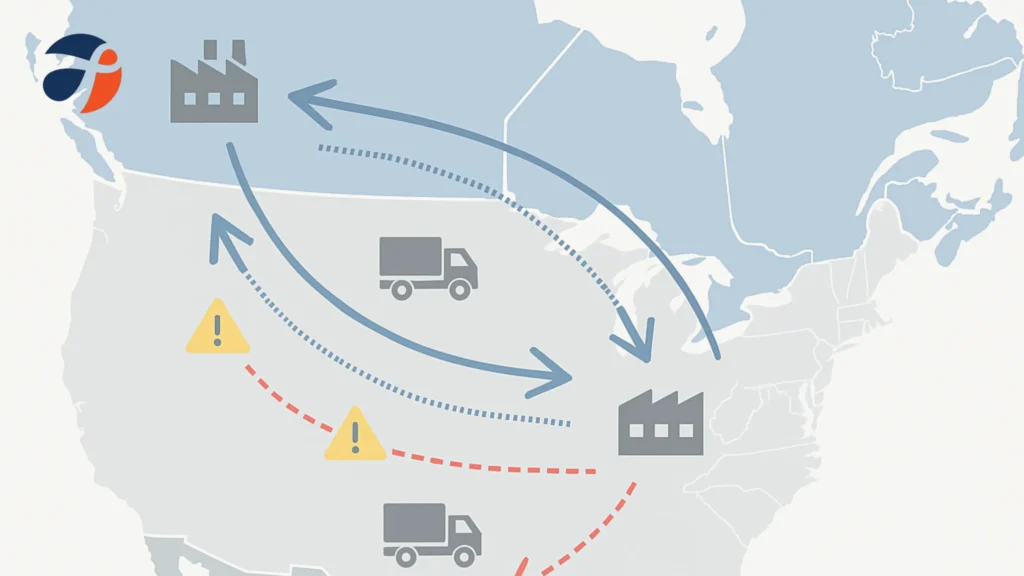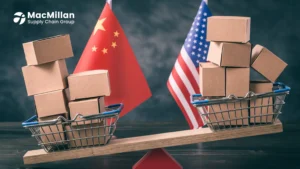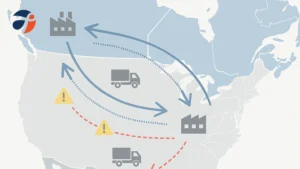Trump’s Proposed Auto Tariffs and Canada’s Automotive Future
Donald Trump, the former president of the United States, has suggested imposing a 25% tariff on imported automobiles and auto parts, which could revolutionize the automotive industry in Canada. The highly intertwined Canadian-American auto industry, where billions of parts and automobiles cross the border each year, would be greatly impacted by this policy. Vehicles that comply with the USMCA may be partially exempt, but Canadian manufacturers must demonstrate U.S. content levels, handle additional administrative requirements, and possibly reorganize supply chains. The MacMillan Supply Chain Group looks at how these tariffs might change the auto industry in North America, what steps need to be taken to comply, and how Canadian suppliers can adjust to stay competitive in this shifting trade landscape.
Understanding the Impact of Trump’s Proposed Auto Tariffs
The automotive industry is about to undergo significant change, and Canadian manufacturers must be aware of this. The North American auto manufacturing network would be impacted by Trump’s proposed auto tariffs, which would impose a 25% tax on cars and parts entering the country. These tariffs pose a serious threat to the status quo for Canada, which exports more than $30 billion worth of automobile goods to the United States each year.
With parts frequently traveling across borders several times before a vehicle is finished, the Canadian auto industry has prospered as a component of an integrated continental supply chain. This smooth movement might become more difficult and expensive under the proposed tariffs. Vehicles that fulfill USMCA requirements might be eligible for partial exemptions, but demonstrating compliance necessitates additional paperwork and verification.
We at MacMillan Supply Chain Group are aware of how important these developments are. Let’s examine how these changes may affect cross-border auto manufacturing, what they mean for Canadian auto suppliers, and what tactics can be used to deal with this changing environment.
How Trump’s Suggested Auto Tariffs Work
A significant change in North American trade relations is reflected in Trump’s proposed auto tariffs.Amid national security concerns, these tariffs would impose a 25% tax on imported cars and parts under Section 232 of the Trade Expansion Act. But, what does this really mean for Canadian Manufacturers?
How the Tariffs Would Work
Vehicles are treated differently depending on their origin and content thanks to the tariff structure’s tiered system:
- Vehicles from Europe and Asia that are not covered by the USMCA would be subject to a full 25% tariff on their total value.
- Only the non-U.S. content of USMCA-compliant vehicles would be subject to tariffs; precise tracking of part origins is necessary for calculation methods.
For instance, tariffs would be applied to the remaining 70% ($42,000) of a $60,000 car built in Canada that has 30% U.S. content, resulting in a $10,500 tariff. The economics of cross-border manufacturing are significantly altered by this.
According to the implementation timeline, procedures should be in place by June 2025, which leaves businesses with little time to adjust. This calls for a quick review of content sources and supply chains for Canadian auto suppliers.
One should not undervalue the administrative burden. Systems for monitoring and certifying the percentage of U.S. content in each component and completed vehicle must be put in place by businesses. This calls for spending money on supply chain visibility tools and documentation systems, which many smaller Canadian parts manufacturers might not have at the moment.
USMCA Compliance: The Secret to Effective Tariff Management
USMCA compliance is now a business survival strategy for Canadian auto parts manufacturers rather than just a legal necessity. It is now crucial to comprehend the intricate regulations that establish whether a product is eligible for preferential treatment.
Critical USMCA Requirements
Vehicles must fulfill a number of requirements in order to be eligible for tariff exemptions under the USMCA:
75% of essential components must be made in North America; 70% of steel and aluminum must be obtained locally; and 40–45% of the content must come from businesses that pay employees at least $16 per hour.
Many Canadian auto suppliers that source materials from around the world will find it difficult to comply with these thresholds, which are a major increase over earlier NAFTA requirements.
Another level of complexity is introduced by the certification procedure. Although USMCA takes a more flexible approach than NAFTA’s formal certificates of origin, it still necessitates thorough documentation.Companies must maintain comprehensive records that specify where each component comes from and what value additions were made in North America.
This presents a dual challenge for smaller Canadian parts manufacturers, who must put in place reliable tracking systems in addition to adhering to stricter content requirements. As automakers look for suppliers who can help them avoid tariffs, those who are unable to certify North American content may find themselves at a significant competitive disadvantage.
According to industry experts, many auto suppliers have already seen a 5–10% increase in administrative costs as a result of USMCA compliance costs. Businesses must balance these compliance expenses against possible tariff savings in light of the additional pressure from tariffs.
Reshaping Cross-Border Supply Chains
The way North American automotive supply chains function may be drastically changed by the proposed tariffs. The current system permits parts to cross borders several times during production because it is based on decades of integration. Under new tariff structures, this effective model might no longer be financially viable.
Possible Disruptions to the Supply Chain
Just-in-time delivery methods, which reduce inventory costs, are crucial to the production of automobiles in Canada. These carefully calibrated systems could be upset by tariffs in a number of ways:
- Delays at the border due to heightened customs scrutiny; higher inventory costs as businesses prepare for unforeseen events
- There are incentives to source more components domestically and pressure to concentrate production on one side of the border.
Early indications of supply chain diversification are already visible as businesses make backup plans. Some Canadian automakers are looking into opening or growing their operations in the United States, especially for expensive parts that would be subject to high tariffs.
More drastic changes are being contemplated by others. Some manufacturers are considering restructuring their entire supply networks instead of just moving their production facilities. By establishing more independent production ecosystems in each nation, this could result in fewer cross-border movements.
These changes present opportunities as well as threats to Ontario and Quebec’s automotive clusters in Canada. Although some production may move south, manufacturers looking to keep North American content levels may choose to do business with Canadian facilities that have special capabilities or strong USMCA compliance positions.
In addition to direct automakers, the Canadian auto industry ecosystem’s logistics, raw material, and service providers are also impacted.
Economic Effects on Canada’s Automobile Industry
Trump’s proposed auto tariffs could have far-reaching economic effects on entire communities and the Canadian economy as a whole, in addition to specific businesses. The stakes are particularly high because automobile exports to the US account for 20% of Canada’s total merchandise exports.
Risky Jobs and Investments
About 125,000 people are directly employed in Canada’s automotive industry, and hundreds of thousands more work in related sectors. According to economic analysis, if businesses move production to avoid tariffs, tariffs could jeopardize 10–15% of these positions.
There are already indications of caution in investment patterns. As businesses wait for clarity on the implementation of tariffs, a number of planned expansions of Canadian automotive facilities have been put on hold. Long-term effects on Canadian manufacturing capacity may result from this investment uncertainty.
Since Ontario is home to the majority of Canadian auto manufacturing, the regional impact would be especially concentrated there. If auto production drops, towns like Windsor, Oshawa, and Brampton may experience serious economic difficulties.
The supply chain as a whole would be under financial strain. If orders drop or payment terms lengthen as a result of tariff issues, Tier 2 and Tier 3 suppliers typically smaller Canadian businesses with little cash on handmay experience serious cash flow issues.
Not all economic effects, though, would be adverse. Reshoring programs may help some Canadian manufacturers as the value of North American content rises. Automakers looking to streamline their supply chains under the new regulations may place a greater demand on businesses with distinctive capabilities and strong USMCA compliance positions.
Issues Canadian Auto Suppliers Face
For businesses across Canada’s automotive supply chain, the proposed tariffs present a number of serious obstacles:
Complexity of Compliance
The advanced tracking systems required to certify U.S. content percentages are absent from many Canadian auto parts manufacturers. They are at a competitive disadvantage since they are unable to assist their clients in obtaining tariff exemptions without these systems.
Uncertainty in Pricing
Canadian suppliers find it difficult to give customers long-term pricing commitments because tariffs have the potential to alter the cost structure of cross-border manufacturing. Future planning and contract negotiations are made more difficult by this uncertainty.
Reluctance to Invest
As long as tariff policies are unclear, businesses are hesitant to make significant capital expenditures. This could put Canadian facilities at a technological disadvantage and postpone modernization efforts.
Supply Chain Weaknesses
Numerous Canadian producers depend on international supply chains that might not satisfy USMCA content standards. These networks are costly and time-consuming to restructure.
Retaliatory Actions
The ensuing trade tensions could further disrupt automotive supply chains and raise costs for all parties involved if Canada responds with counter-tariffs.
Pressures on Cash Flow
Smaller suppliers may face significant financial difficulties if tariffs need to be paid in advance before clients reimburse them, or if payment terms are extended due to administrative problems.
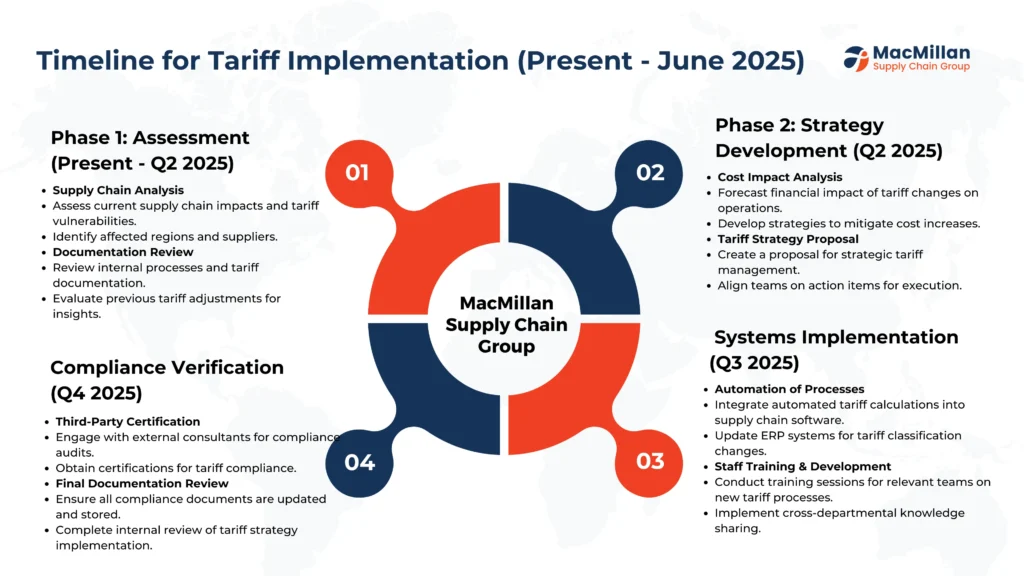
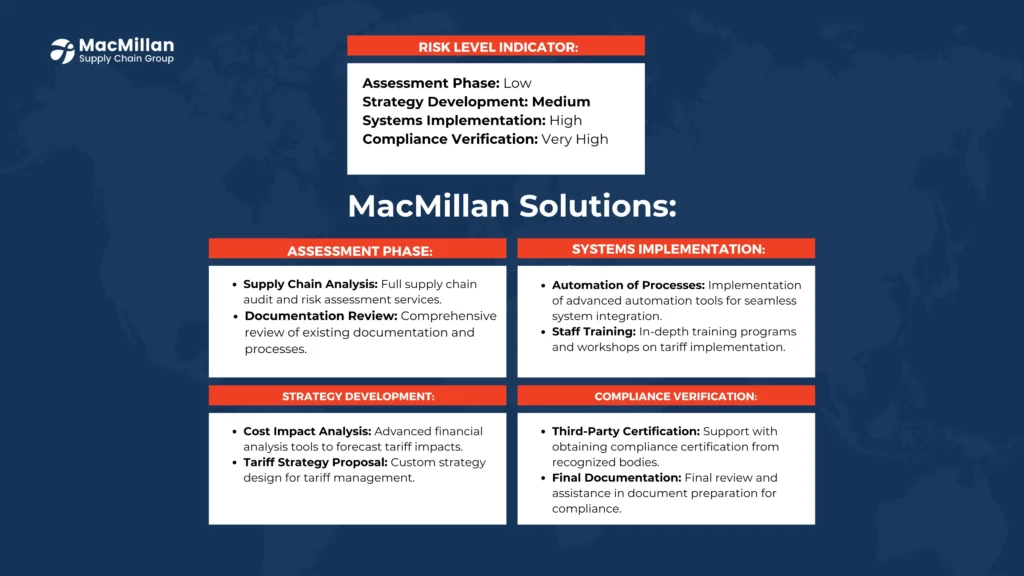
How to Handle Auto Tariffs with the MacMillan Supply Chain Group
We at MacMillan Supply Chain Group have created all-inclusive solutions to assist Canadian auto suppliers in adjusting to the evolving tariff environment. Our method blends operational excellence, strategic planning, and in-depth understanding of international trade.
USMCA Compliance Support
Trade compliance specialists on our team are available to assist you:
Examine your current supply chain to determine whether it qualifies for the USMCA; identify any elements that could compromise compliance; create documentation systems that monitor and confirm the origin of content; and create certification paperwork that satisfies customs requirements.
By locating substitute suppliers in the area, we have assisted several automakers in raising their North American content percentages. In order to shield themselves from possible tariff exposure, we collaborated with a parts manufacturer located in Ontario to raise their USMCA-compliant content from 68% to 79%.
Supply Chain Redesign
Our supply chain engineers can assist you in restructuring your business to reduce the impact of tariffs while preserving productivity:
- Analyze the financial effects of various supply chain arrangements.
- Find ways to combine production in particular nations.
- Create backup plans for different tariff situations.
- Place inventory as efficiently as possible to protect against border disruptions.
For instance, in order to increase their capacity to satisfy USMCA labor value content requirements, we assisted a Canadian supplier of aluminum parts in restructuring their production flow to accomplish more value-added processes domestically.
Logistics Optimization
Our knowledge of logistics can help manage the growing complexity of cross-border movements:
Simplify customs paperwork to avoid delays at the border; Create alternate routes to ensure delivery dependability; Put in place visibility systems to monitor shipments and possible interruptions; and Strategically manage inventory to protect against supply chain uncertainties.
Solutions for Finance
Additionally, we provide the following solutions to help control the financial impact of tariffs:
- Programs for duty drawbacks that allow for the recovery of tariffs paid on re exported goods; options for financing inventory to control cash flow during transitions
- Tools for cost modeling to examine the effects of tariffs on various product lines
- Models of strategic pricing that account for possible tariff situations
Technology Implementation
Among our digital supply chain solutions are:
- Analytics platforms that simulate various tariff scenarios – Origin tracking systems that keep track of documentation for USMCA certification
- Tools for managing suppliers that keep an eye on network compliance; real-time dashboards that show tariff exposure and compliance status
MacMillan Supply Chain Group offers a thorough strategy for overcoming the difficulties posed by Trump’s proposed auto tariffs by integrating these solutions. Our clients are putting themselves in a position to prosper in the new trade environment, not just surviving these changes.
Acting: Getting Your Company Ready for Auto Tariff Changes
Now is the time to get ready for possible auto tariffs before they go into effect. The following are doable actions that Canadian auto suppliers can take to set themselves up for success:
Start with a Compliance Assessment
Start by carefully examining your present position regarding USMCA compliance:
- What proportion of your parts come from North America?
- Which vendors could jeopardize your compliance status?
- Do you possess the systems for documentation required to verify origin?
Your biggest weaknesses and areas for development will be found by this baseline evaluation.
Create a Multi-Scenario Plan
Instead of waiting for the final tariff details, make plans for a number of possible outcomes:
- If full tariffs were imposed, what adjustments would you make?
- In what ways might partial exemptions alter your strategy?
- Which modifications to the supply chain provide the greatest flexibility?
You can react swiftly as policies change thanks to this scenario planning.
Strengthen Your Documentation Systems
Strong documentation will be necessary regardless of the final tariff structure:
- Establish component origin tracking systems.
- Educate employees on USMCA certification requirements.
- Create audit procedures to confirm claims of compliance.
Talk to Supply Chain Professionals
MacMillan Supply Chain Group can offer outstanding value in this situation. Our group specializes in managing intricate trade regulations and streamlining international supply chains. We are able to assist you:
Perform a thorough tariff impact analysis; create specialized compliance plans; put in place the systems required to document and certify origin; and streamline your logistics network to reduce tariff exposure.
Avoid delaying on setting up your preparations until after tariffs are imposed. To arrange a consultation about how MacMillan Supply Chain Group can assist your company in effectively navigating these changes, get in touch with us right now. Together, you and our experts will create a customized plan that safeguards your competitive edge and transforms possible disruption into opportunity.
We’re well-positioned to help your company through this transition because we have offices across Canada and a wealth of experience in automotive logistics. To find out more about our automotive supply chain solutions, give us a call at 416-941-2759 or visit our website.
FAQS
Trump's proposed auto tariffs would impose a 25% tax on imported vehicles and auto parts entering the United States. For USMCA-compliant vehicles, tariffs would apply only to the non-U.S. content portion. For example, if a Canadian-made vehicle contains 30% U.S. parts, the 25% tariff would apply to the remaining 70% of the vehicle's value.
Based on current information, the processes for implementing these tariffs are expected to be in place by June 2025. However, this timeline could change depending on political developments and implementation challenges. Companies should prepare for potential implementation as early as mid-2025.
USMCA requires 75% of core automotive parts to originate in North America, up from 62.5% under NAFTA. Additionally, 70% of steel and aluminum must be sourced from the region, and 40-45% of content must come from facilities paying workers at least $16/hour. Canadian manufacturers must meet these thresholds to help their customers qualify for tariff exemptions.
Canadian automotive suppliers will need to maintain detailed records showing the origin of all components and materials. This includes supplier declarations, manufacturing records, and value calculations. Unlike NAFTA's formal certificate of origin, USMCA uses a more flexible approach but requires comprehensive supporting documentation that can be produced during audits.
Yes, there's a significant risk that some production could relocate to avoid tariffs. Components with high tariff exposure might be prioritized for U.S. production, while Canada might retain manufacturing of items with strong USMCA compliance or specialized capabilities. The extent of production shifts will depend on the final tariff implementation details and individual company strategies.
Based on historical precedent, Canada might implement retaliatory tariffs on U.S. goods if auto tariffs are imposed. In previous trade disputes, Canada targeted specific U.S. products with political significance. Such retaliatory measures could further complicate cross-border supply chains and increase costs for companies operating in both countries.
Most economic analyses suggest that tariffs would likely increase vehicle prices. Manufacturers would need to pass at least some portion of the tariff costs to consumers. Industry estimates suggest price increases could range from 2-7% depending on the vehicle's origin and content composition.
Smaller suppliers face difficult choices if they cannot meet USMCA thresholds. Options include partnering with North American material suppliers to increase regional content, exploring joint ventures with U.S. companies, or potentially shifting focus to Canadian or export markets less affected by the tariffs. Working with supply chain experts like MacMillan Supply Chain Group can help identify the most viable strategy.
Companies should conduct a comprehensive analysis of their product content, identifying the origin of all components and materials. This analysis should calculate the percentage of U.S. content in finished goods and identify high-risk components that could trigger tariffs. Supply chain mapping tools can help visualize these relationships and quantify potential financial impacts.
The most critical technology investments relate to origin tracking and documentation. Systems that can trace component origins throughout the manufacturing process, maintain required documentation, and generate compliance certifications will be essential. Additionally, analytics platforms that can model different tariff scenarios can help with strategic planning and customer negotiations.
